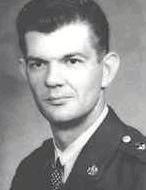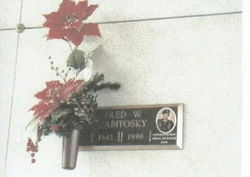b. 27/10/1942 Trenton, New Jersey. d. 08/01/1996 Durham, North Carolina.
DATE OF MOH ACTION: 19/02/1968 Laos.
Zabitosky was born October 27, 1942, into a poor community in Trenton, New Jersey, to parents Cora and Fred T. Zabitosky. When Zabitosky was 15, his father left the family, forcing the teen to take responsibility for his mother, brother and three sisters. To earn money for the family, Zabitosky dropped out of high school after his junior year. At age 17, he realized that joining the military could offer better stability and support, so in 1959, he enlisted in the Army.
After basic training, Zabitosky was sent to Germany for three years, where he served with distinction before coming home and rejoining civilian life. He got a job working construction, but he wasn’t happy with that, so he decided to reenlist in 1963, this time to join the Special Forces. After much training, he became a Green Beret with the 5th Special Forces Group.
In 1964, Zabitosky married his girlfriend, Carrie Mae, before being sent to Vietnam. He returned a year later to his wife and his first child, a boy named Edward. Soon after, however, Zabitosky itched to return to the action, so he volunteered to go back to the war zone, where he helped train South Vietnamese soldiers. He again returned home just to volunteer to go back to Vietnam for a third tour of duty in 1968. It was on this deployment during the height of the Tet Offensive that he earned the Medal of Honor.
Zabitosky’s team was tasked with monitoring the Ho Chi Minh Trail, which often required crossing into neighboring Laos and Cambodia on convert missions. On Feb. 19, 1968, during one of these quests into Laos, Zabitosky was the assistant team lead of a nine-man reconnaissance patrol that stumbled into a large enemy complex. Quickly, all hell broke loose.
According to his Medal of Honor citation, Zabitosky exposed himself to enemy fire so he could rally his comrades and deployed them into defensive positions to return fire. When he realized how outnumbered they were, he ordered them to move to a landing zone for helicopter extraction, all while he covered their withdrawal with rifle fire and grenades.
After about an hour and a half of his team maintaining a tight position to keep the enemy at bay, three helicopters finally arrived. But the North Vietnamese continued to press their attack, which forced Zabitosky to repeatedly expose himself to more danger so he could “adjust suppressive helicopter-gunship fire around the landing zone,” his citation said.
Eventually, he and a few of his men got onto the second helicopter. Zabitosky positioned himself by the door so he could continue firing at the enemy as it took off. As it did, a rocket-propelled grenade came straight toward them, hitting the helicopter in the tail and causing it to crash.
Zabitosky was thrown from the aircraft and initially lost consciousness. When he came to, he was seriously injured — he later learned he’d broken his back and several ribs — but he ignored the extreme pain and ran to the chopper wreckage to try to save those stuck inside. Ignoring the dangers of fuel and ordnance exploding around him, Zabitosky managed to pull the severely wounded pilot from the aircraft, as well as the copilot. His citation said he tried to rescue the members of his team who were also on the aircraft, but he was driven back by the intense heat.
Zabitosky managed to drag the two pilots through a hail of enemy gunfire to within 10 feet of a third helicopter that was hovering above the ground. Once he’d loaded the pilots onto it, he tried to go back to the downed chopper one more time, but he collapsed. He was loaded into the third chopper with the pilots and whisked away. Zabitosky was taken to a hospital in South Vietnam and was unable to walk for about a month. Six weeks into his recovery, he was sent back to the U.S.
On March 7, 1969, just more than a year after his heroic exploits, Zabitosky received the Medal of Honor from President Richard M. Nixon at a White House ceremony. Two other soldiers, Staff Sgt. Joe Hooper and Spc. 5th Class Clarence Sasser, were also given the medal that day.
Zabitosky remained in the Army for nearly another decade, retiring after 18 years of service in 1977, according to the News and Observer newspaper out of Raleigh, North Carolina. He and his family, which expanded to include a daughter, remained in North Carolina.
As a civilian, Zabitosky continued working with the military as a counselor for the Department of Veterans Affairs at Fort Bragg. In February 1982, he made one last trip to Vietnam, this time to investigate the possible existence of American prisoners of war and those missing in action.
Zabitosky died on Jan. 8, 1996, after undergoing surgery to treat a cancerous brain tumor, according to the News and Observer. He is buried in Lumbee Memorial Gardens in Lumberton, North Carolina.
The celebrated Green Beret’s name may be familiar to any Special Forces service members visiting Fort Bragg, which is now Fort Liberty. The main thoroughfare at the Special Warfare School — Zabitosky Street — is named in his honor. In 2017, a memorial display dedicated to Zabitosky was also erected at the Ewing Township Municipal Building near his hometown.
In 2019, Zabitosky’s Medal of Honor was put on display at the U.S. Army Airborne and Special Forces Museum in North Carolina. It’s now currently part of the JFK Presidential Library and Museum collection.
MOH CITATION:
For conspicuous gallantry and intrepidity in action at the risk of his life above and beyond the call of duty. Sfc. Zabitosky, U.S. Army, distinguished himself while serving as an assistant team leader of a nine-man Special Forces long-range reconnaissance patrol. Sfc. Zabitosky’s patrol was operating deep within enemy controlled territory in Laos when they were attacked by a numerically superior North Vietnamese Army unit. Sfc. Zabitosky rallied his team members, deployed them into defensive positions, and, exposing himself to concentrated enemy automatic weapons fire, directed their return fire. Realizing the gravity of the situation, Sfc. Zabitosky ordered his patrol to move to a landing zone for helicopter extraction while he covered their withdrawal with rifle fire and grenades. Rejoining the patrol under increasing enemy pressure, he positioned each man in a tight perimeter defense and continually moved from man to man, encouraging them and controlling their defensive fire. Mainly due to his example, the outnumbered patrol maintained its precarious position until the arrival of tactical air support and a helicopter extraction team. As the rescue helicopters arrived, the determined North Vietnamese pressed their attack. Sfc. Zabitosky repeatedly exposed himself to their fire to adjust suppressive helicopter-gunship fire around the landing zone. After boarding one of the rescue helicopters, he positioned himself in the door delivering fire on the enemy as the ship took off. The helicopter was engulfed in a hail of bullets and Sfc. Zabitosky was thrown from the craft as it spun out of control and crashed. Recovering consciousness, he ignored his extremely painful injuries and moved to the flaming wreckage. Heedless of the danger of exploding ordnance and fuel, he pulled the severely wounded pilot from the searing blaze and made repeated attempts to rescue his patrol members but was driven back by the intense heat. Despite his serious burns and crushed ribs, he carried and dragged the unconscious pilot through a curtain of enemy fire to within 10 feet of a hovering rescue helicopter before collapsing. Sfc. Zabitosky’s extraordinary heroism and devotion to duty were in keeping with the highest traditons of the miltary serrvice and reflect great credit upon himself, his unit, and the U.S. Army.
BURIAL LOCATION: LUMBEE MEMORIAL GARDENS, PEMBROKE, NORTH CAROLINA.
COLUMBARIUM.
LOCATION OF MEDAL: JFK PRESIDENTIAL LIBRARY AND MUSEUM, BOSTON, MASSACHUSETTS.

